Wristing all – hand and wrist exercises, considerations in a pilates studio setting
Mon,Jan 28, 2019 at 08:13PM by Carla Mullins
More than two decades ago I started to experience severe wrist and hand pain for the first time, and unfortunately not the last. I must admit it was excruciating and incredibly frustrating not to be able to use my hands for basic living tasks. Probably one of the lowest points of my life was during that period of time, when I ended up sitting in a gutter sobbing because carrying a loaf of bread was too painful. The road to recovery for my hands was a long one; I have to admit that there have been times when I have had my set backs and the old foe – wrist pain – returns. The peripheral neuropathy in the hands is constant and requires constant focus and effort to keep it at bay. The process has taught me many things, including:
// Empathy for those in pain, because when it hits you it is difficult to concentrate and make chit chat
// Appreciation of load and tolerance in the recovery process
// Pacing and ensuring that you do not get into the boom bust cycle
// Creativity in finding ways to work with the hands and wrists
// And last but not least, it is very hard to dress and feed yourself if you can’t use your hands
In this article I will:
// Give you a quick review of some anatomy
// Share with you some of my favourite ways to strengthen the arches of the hands, and improve grip
// Explore ideas to minimise compression on the wrists and protect the joints
// Explore more hand-friendly ideas to strengthen the shoulders in order to reduce neural compression
Anatomy of the hands
The hand is very similar to the structure of the foot, with 26 bones and three main ligamentous arches designed to support the delicate carpal bones and support the intrinsic muscles of the hand. However the hand, unlike the foot, needs to be dexterous and highly sensitive to achieve the many tasks we perform as humans. In an adult the hand is not designed for weight bearing, which is very different to children who will crawl as part of their development. Remember that the fixation of the hands in crawling is part of a child’s process of developing shoulder strength. It is important to remember that in a child the carpal bones are not fully formed and as such when crawling a baby’s hand can be flat on the ground without creating compression. It is hard to believe that the important scaphoid bone is not formed until between the ages of 5 and 7.
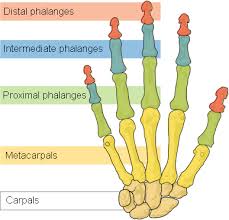
The major bones of the hands, giving you an insight into all of the synovial joints that are needed for us to even type on the computer.
To support the carpal bones there are four major arches of the hand (see image below). The arches are important for direction of your fingers and grasp strength. Let’s remember that with 26 bones there are a lot of joints that can be affected in the hand, so good alignment and balance of strengthening of the hands is very important. The hands can be affected by many joint issues such as arthritis, and as such care on protecting the joints is important.
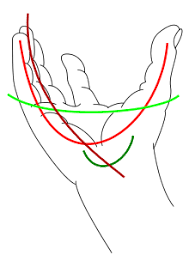
The three major arches of the hand – the green is the Distal Transverse Arch; red is Oblique Arch; brown the Longitudinal Arch.
The nerves that pass into the hand start at the neck and transit through the brachial plexus. Accordingly, if a person is complaining of nerve pain, that burning stinger type pain, it is important to make sure that it is not coming from neck related problems. In those situations I always make sure their manual therapist such as a physiotherapist has made a thorough investigation of the neck.
It is important to remember that the carpal bones articulate with the radius and ulna bones, which forms the wrist. Maintaining space in the wrist is essential for protection of the joint. You can see that the radius and ulna bones connect with each other twice at pivot joints, once at the wrist and the other at the elbow. Space around these pivot joints and at the elbow and wrist is important so that the pivoting can occur to allow for the the supination and pronation actions necessary when move our hands.
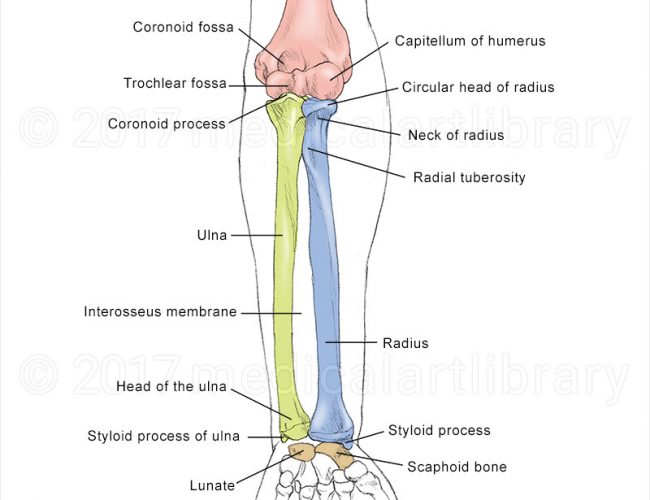
Hand placement in four point and plank
When we think of the hand it is also important to remember that the median nerve runs through the important carpal tunnel. It is compression of that nerve that can cause pain. The compression of the carpal tunnel can occur for a number of reasons, but a significant factor in a movement class could be attributable to incorrect loading of the wrists in exercises like 4 point kneeling or plank. It is another one of the reasons that I get a bit obsessed with hand alignment. I do not like to see the hand directly underneath the shoulder once the person is in their adult years.
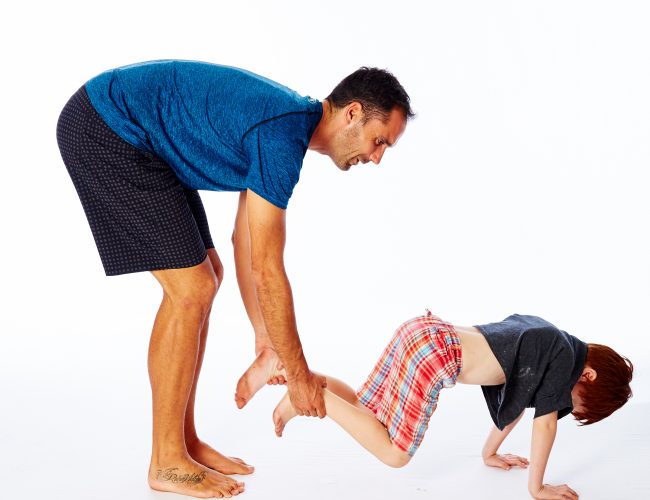
In this photo Max is about 4- 5 years of age and his carpal bones are still forming. When playing wheelbarrow he is working on shoulder strength but not loading up the unformed joints and arches in his hands.
In an adult the bones are fully formed and there is less space between the carpal bones and the ulnar and radial bones. As our bones ossify the space between the carpal bones diminishes and the role of the ligamental arches of the hands become more important to protect those joints.
Experience One
Try putting your hands flat on to the table or floor and have your shoulder directly over your hands, so that the wrists are at a 90 Degree angle. Can feel the compression in the wrists?
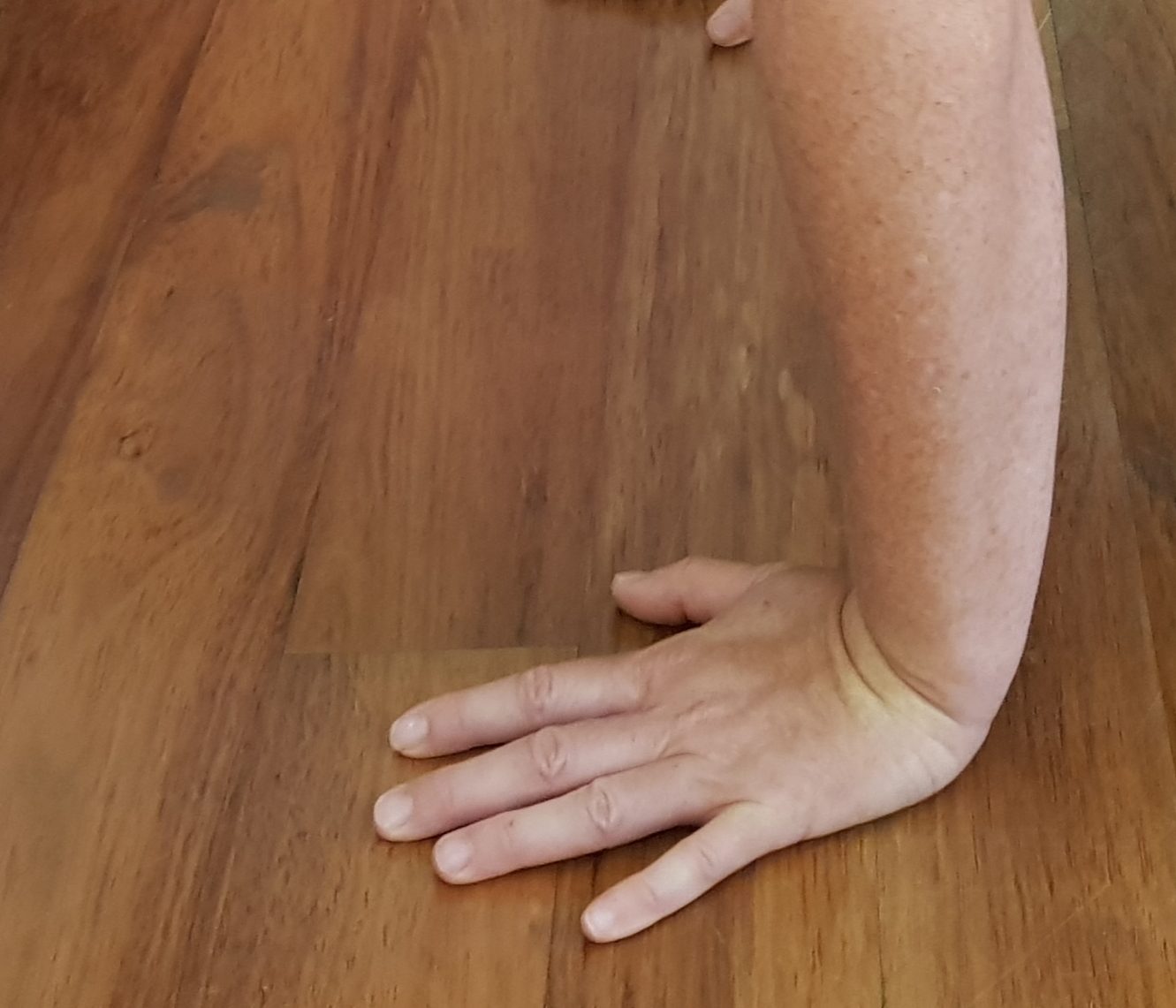
Note not only the compression at this angle but also the lack of activation of the hand instrinsic muscles.
This compression gets greater as we age, hence why many people complain about the load in their wrists when they do exercises like plank, pike and downward dog. Their teachers or therapists don’t really listen to the complaint so the client tends to disengage from the studio or clinic and can just disconnect from work that is challenging, which could have been avoided had some simple modifications been applied. Then of course there are those that don’t complain and just keep on doing damage as they “work through the pain”. Supporting the wrists with a towel or Makarlu Lotus hardwood base (see image below) can be useful for joint protection.
Remember, when the hands are on the ground the whole arm is fixed, which is great for building shoulder strength, particularly for children, but not so great for the wrists. To help alleviate the load on the wrists I place the hands slightly forward of the shoulder and bend the elbows slightly. When the elbows are bent it means that the radius and ulna of the forearm can pivot (supination and pronation) around each other, facilitating the space in the wrists but also the responsiveness of the tricep and bicep muscles. The tricep and bicep group of muscles run from the scapula and then insert at the ulna and radius.
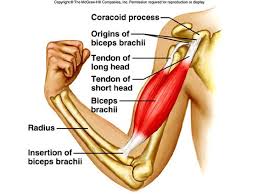
In this image you can see how the biceps join the scapula and the forearm bones (radius).
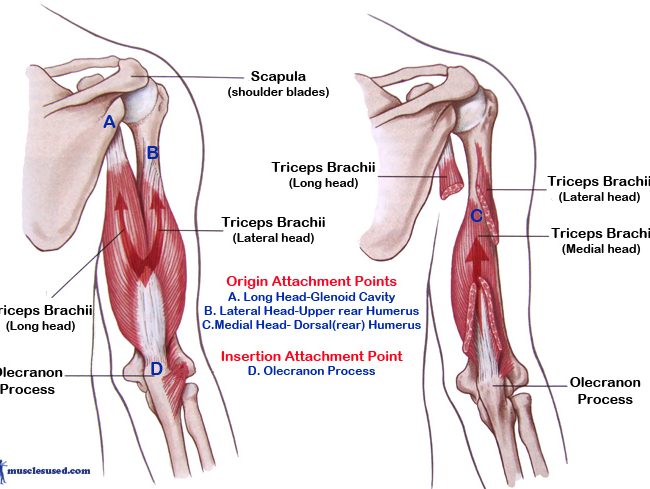
In this image you can see how the tricep muscles join the scapula to the ulna.
Experience Two
To understand this better, go into four point kneeling and try having your arms locked exactly under your shoulders. Observe what it feels like to try and roll your humeral head in their shoulder joint. Notice if you end up locking down on the scapula when you do this, rather than activating the rotator cuff muscles that help to stabilise the shoulder. When you do this, observe your rib cage and whether or not it has lost some of its mobility?
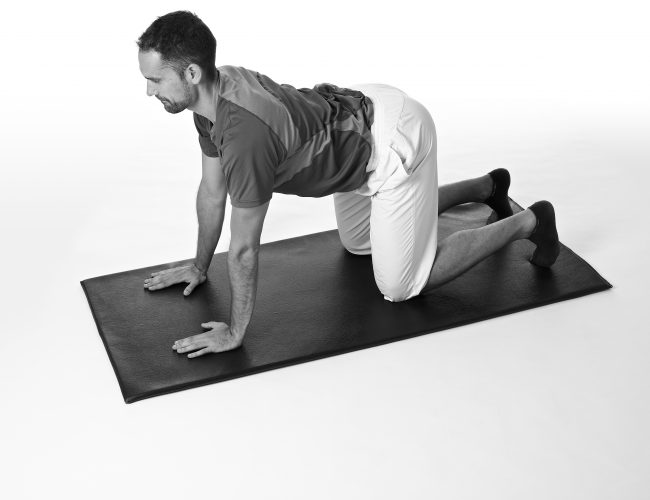
In this image you can see how the arms are straight and the wrists are compressed.
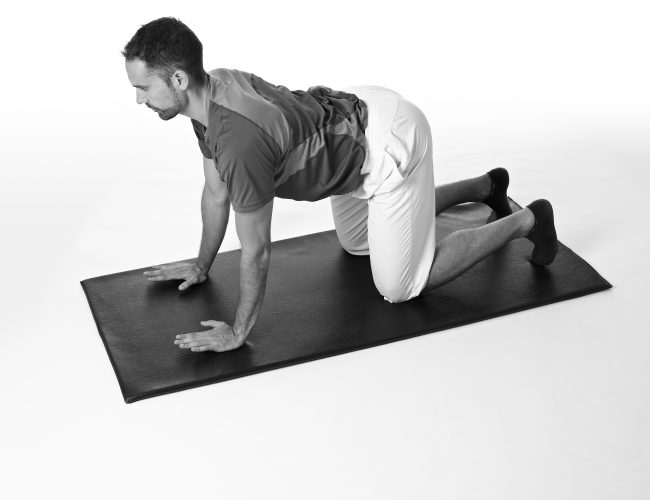
In this situation Manuel has a slight bend to elbow and places more focus at the scaphoid bone rather than on the wrist itself.
Experience Three
Start with your body in four point kneeling and put your hands slightly forward of the shoulders, bend your elbows slightly and place a bit of pressure on the scaphoid bone (the bone just near the base of the thumb and the wrist). Keep the elbows slightly soft and now feel what happens when you roll your humeral head around and into place.
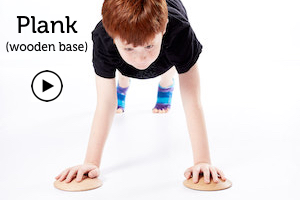
In this series Max is working through plank and other shoulder girdle movements by using a Makarlu hardwood base as a slider to facilitate more dynamic movement.
Let’s not forget that when we do many four point kneeling exercises on the reformer, our hands are on the Reformer foot bar and as such our arms are slightly forward and bent so that there is sufficient room for us to place our shoulders correctly and not load our joints. Once again we can see the genius behind much of the pilates apparatus and how it can support our body positioning and muscle activation.
Some considerations in a pilates studio
1. Strengthening of the intrinsic muscles of the hand
I start with isometric strengthening of the intrinsic muscles of the hand to de-load the carpal bones and to strengthen the forearm and shoulders.
My personal experience was that holding a hand weight was too compressive because it required me to close the hand and the load was too hard to control. Over the years I have worked out that I need to start with my hand in an outstretched position and focus on connecting the arches, a bit like I would do if I was working with my feet. The only problems is that if I do four point kneeling work on the floor to strengthen my hands, it can also be compressive on the wrist joints. Below are some ways that I have worked to try and overcome the problems.
Holding Makarlu hardwood base on the edges, keeping a focus on the activation of the arches of the hand as I press my fingers into the edge of the disc.
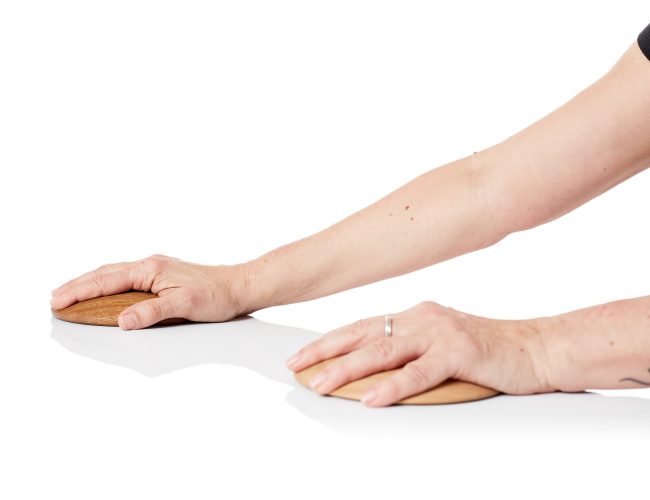
Other ideas include starting with my hands on a wall so that I am not loading the wrists and can still work on shoulder organisation and hand activation. Eventually though, I do want to aim to get people to work on the floor.
If I am working on the Gyrotonic tower apparatus I like to place my fingers on the top of the handle units and have a sense that my hand is pulling the handle units up with my finger tips. When working on the Gyrotoner I like to have the sensation that my hands are pulling the handle units (when in upright position) apart with my finger tips.
2. Progressive loading of the hands
One of the great benefits of pilates is its ability to progressively load through its use of springs. Although I must admit that when my hands are bad, the hands in strap series even on the lightest spring can be fraught with danger as the grip of the hands on the straps can place a focus on the forearm rather than the strengthening of the wrists. This loading becomes very important when you work with conditions such as De Quervains.
Some of the strategies that I have developed for myself and some of my clients are:
// Placement of the straps on the carpal bones rather than around the thumb saddle joint, which is often affected by conditions like rheumatoid arthritis
// Putting the hardwood base of the Makarlu in the straps (see video below), which is surprisingly stable and very effective. If you need to make the strap-to-Makarlu setting more secure I suggest you put a rubber band or hair band around the client’s wrist.
3. Protection of the joints
For some people this will mean wearing a splint or over supportive device to protect the individual joints in the hand and the wrists from further damage. This is particularly important when working with clients with conditions such as rheumatoid arthritis. Furthermore, make sure that you do not have the person working
4. Keeping the forearms loose and hands in front of the body, not immediately under the shoulder.
5. Ensure that when the hands are on the ground in a plank that the thumbs are distant from each other, never sitting in a position that would place them medial to the coracoid process.
When the hands are too narrow in their position the pectoralis and caracobrachialis muscles which attach to the coracoid process are contracted and reduce mobility of the scapular. This can result in a restriction of the shoulder, potential brachial plexus compression, poor shoulder mobility and further overloading of the wrists.
Below is a small class that I teach using Makarlu to work on hand strength and flexibility and how to release some of the muscle/fascia in the forearm. Remember, if the muscle is tight it may need to be first released before you strengthen the muscle, so that it can be strengthened in its optimal position.
For those interested in more ideas about the hands you can refer to our articles:
// Ideas for peripheral neuropathy
Body Organics offers the online Anatomy Dimensions Upper Limbs course for those people wanting to learn more about the hands, elbows and shoulders and how to accommodate problems in a pilates studio setting. To learn more about this course click on the image below 
Carla Mullins is co-director and co-owner of Body Organics, a multidisciplinary health and body movement practice with 3 studios in Brisbane. Carla is a Level 4 Professional Practitioner with the APMA and has also studied pilates with APMA, PITC as well as Polestar. She also has a LLB (QUT), M. Soc Sc & Policy (UNSW), Advanced Diploma of Pilates Movement Therapy (APMA), Diploma of Pilates Movement Therapy (APMA) ,Diploma Pilates Professional Practice (PITC), Gyrotonic Level 1,Gyrotonic JSB , Gyrotoner, CoreAlign Level 1, 2 and 3 and Certificate IV in Training and Assessment.
 0
0 